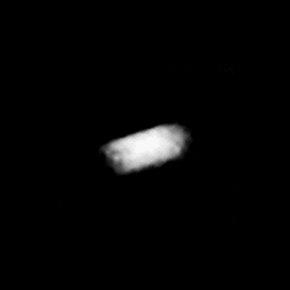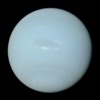Galatea (moon)
 | |
| Discovery | |
|---|---|
| Discovered by | Stephen P. Synnott[1] and Voyager Imaging Team |
| Discovery date | July 1989 |
| Designations | |
Designation | Neptune VI |
| Pronunciation | /ɡæləˈtiːə/[2] |
Named after | Γαλάτεια Galateia |
| Adjectives | Galatean[3] |
| Orbital characteristics[4][5] | |
| Epoch 18 August 1989 | |
| 61952.57 km | |
| Eccentricity | 0.00022 ± 0.00008 |
| 0.42874431 ± 0.00000001 d | |
| Inclination |
|
| Satellite of | Neptune |
| Group | ring shepherd |
| Physical characteristics | |
| Dimensions | (204±10) × (184±16) × (144±8) km[6] |
| 88±4 km[6] | |
| Volume | ~2.8×106 km3[a] |
| Mass | 1.94×1018 kg[8] |
Mean density | ~0.69 g/cm3[b] |
| ~0.012–0.025 m/s2[c] | |
| ~0.05–0.06 km/s[d] | |
| synchronous | |
| zero | |
| Albedo | 0.08[6][9] |
| Temperature | ~51 K mean (estimate) |
| 21.9[9] | |
Galatea /ɡæləˈtiːə/, also known as Neptune VI, is the fourth-closest inner moon of Neptune, and fifth-largest moon of Neptune. It is named after Galatea, one of the fifty Nereids of Greek legend, with whom Cyclops Polyphemus was vainly in love.
Discovery

Galatea was discovered in late July 1989 from the images taken by the Voyager 2 probe. It was given the temporary designation S/1989 N 4.[10] The discovery was announced (IAUC 4824) on 2 August 1989, and mentions "10 frames taken over 5 days", implying a discovery date of sometime before July 28. The name was given on 16 September 1991.[11]
Physical properties
Galatea is irregularly shaped and shows no sign of any geological modification. It is likely that it is a rubble pile re-accreted from fragments of Neptune's original satellites, which were smashed up by perturbations from Triton soon after that moon's capture into a very eccentric initial orbit.[12]
Compositionally, Galatea appears to be similar to other small inner Neptunian satellites, with a deep 3.0 micron feature attributed to water ice or hydrated silicate minerals. It has a 0.08 albedo at 1.4 and 2.0 microns, dropping to 0.04 at 3.0 microns, and increasing to 0.12 at 4.6 microns.[13]
Orbit
Galatea's orbit lies below Neptune's synchronous orbit radius, so it is slowly spiralling inward due to tidal deceleration and may eventually impact the planet or break up into a new planetary ring system upon passing its Roche limit due to tidal stretching.
Galatea appears to be a shepherd moon for the Adams ring that is 1,000 kilometres (620 mi) outside its orbit. Resonances with Galatea in the ratio 42:43 are also considered the most likely mechanism for confining the unique ring arcs that exist in this ring.[14] Galatea's mass has been estimated based on the radial perturbations it induces on the ring.[15][7]
Notes
- ^ Volume derived from the long axis A, the medium axis B and the short axis C:
- ^ Density derived from mass m and the volume V:
- ^ Surface gravity derived from the mass m, the gravitational constant G and the radius r:
- ^ Escape velocity derived from the mass m, the gravitational constant G and the radius r:
Since Galatea is irregularly shaped, the actual surface gravity and escape velocity will vary significantly between different positions on the surface.
References
- ^ Planet Neptune Data http://www.princeton.edu/~willman/planetary_systems/Sol/Neptune/
- ^ "galatea". Oxford English Dictionary (Online ed.). Oxford University Press. (Subscription or participating institution membership required.)
- ^ AMIA (1999), Transforming health care through informatics
- ^ Jacobson, R. A.; Owen, W. M. Jr. (2004). "The orbits of the inner Neptunian satellites from Voyager, Earthbased, and Hubble Space Telescope observations". Astronomical Journal. 128 (3): 1412–1417. Bibcode:2004AJ....128.1412J. doi:10.1086/423037.
- ^ Showalter, M. R.; de Pater, I.; Lissauer, J. J.; French, R. S. (2019). "The seventh inner moon of Neptune" (PDF). Nature. 566 (7744): 350–353. Bibcode:2019Natur.566..350S. doi:10.1038/s41586-019-0909-9. PMC 6424524. PMID 30787452.
- ^ a b c Karkoschka, Erich (2003). "Sizes, shapes, and albedos of the inner satellites of Neptune". Icarus. 162 (2): 400–407. Bibcode:2003Icar..162..400K. doi:10.1016/S0019-1035(03)00002-2.
- ^ a b Madeira, Gustavo; Winter, Silvia Maria Giuliatti (2022-04-21). "Numerical analysis of processes for the formation of moonlets confining the arcs of Neptune". Monthly Notices of the Royal Astronomical Society. 513 (1): 297–309. arXiv:2204.01063. doi:10.1093/mnras/stac944. ISSN 0035-8711.
- ^ Giuliatti Winter et al. (2020), as cited in Madeira & Giuliatti Winter (2022).[7]
- ^ a b "Planetary Satellite Physical Parameters". JPL (Solar System Dynamics). 2008-10-24. Archived from the original on 2013-11-01. Retrieved 2008-12-13.
- ^ Marsden, Brian G. (August 2, 1989). "Satellites of Neptune". IAU Circular. 4824. Retrieved 2011-10-26.
- ^ Marsden, Brian G. (September 16, 1991). "Satellites of Saturn and Neptune". IAU Circular. 5347. Retrieved 2011-10-26.
- ^ Banfield, Don; Murray, Norm (October 1992). "A dynamical history of the inner Neptunian satellites". Icarus. 99 (2): 390–401. Bibcode:1992Icar...99..390B. doi:10.1016/0019-1035(92)90155-Z.
- ^ Belyakov, Matthew; Davis, M. Ryleigh; Milby, Zachariah; Wong, Ian; Brown, Michael E. (2024-05-01). "JWST Spectrophotometry of the Small Satellites of Uranus and Neptune". The Planetary Science Journal. 5 (5): 119. arXiv:2404.06660. Bibcode:2024PSJ.....5..119B. doi:10.3847/PSJ/ad3d55. ISSN 2632-3338.
- ^ Namouni, F.; Porco, C. (2002). "The confinement of Neptune's ring arcs by the moon Galatea". Nature. 417 (6884): 45–7. Bibcode:2002Natur.417...45N. doi:10.1038/417045a. PMID 11986660. S2CID 4430322.
- ^ Porco, C.C. (1991). "An Explanation for Neptune's Ring Arcs". Science. 253 (5023): 995–1001. Bibcode:1991Sci...253..995P. doi:10.1126/science.253.5023.995. PMID 17775342. S2CID 742763.






